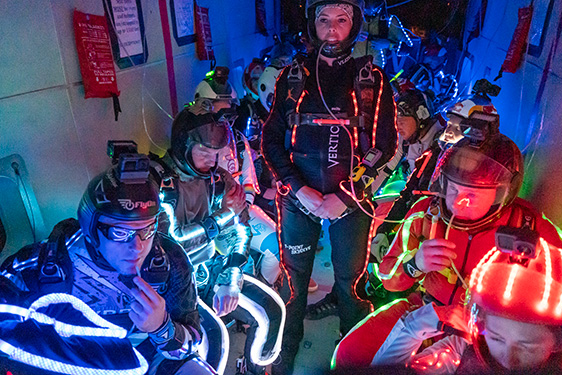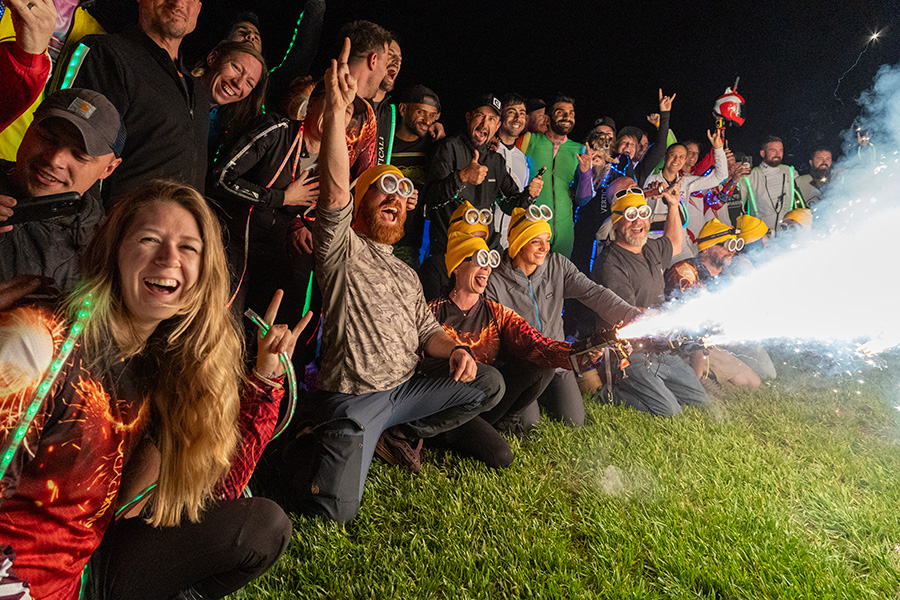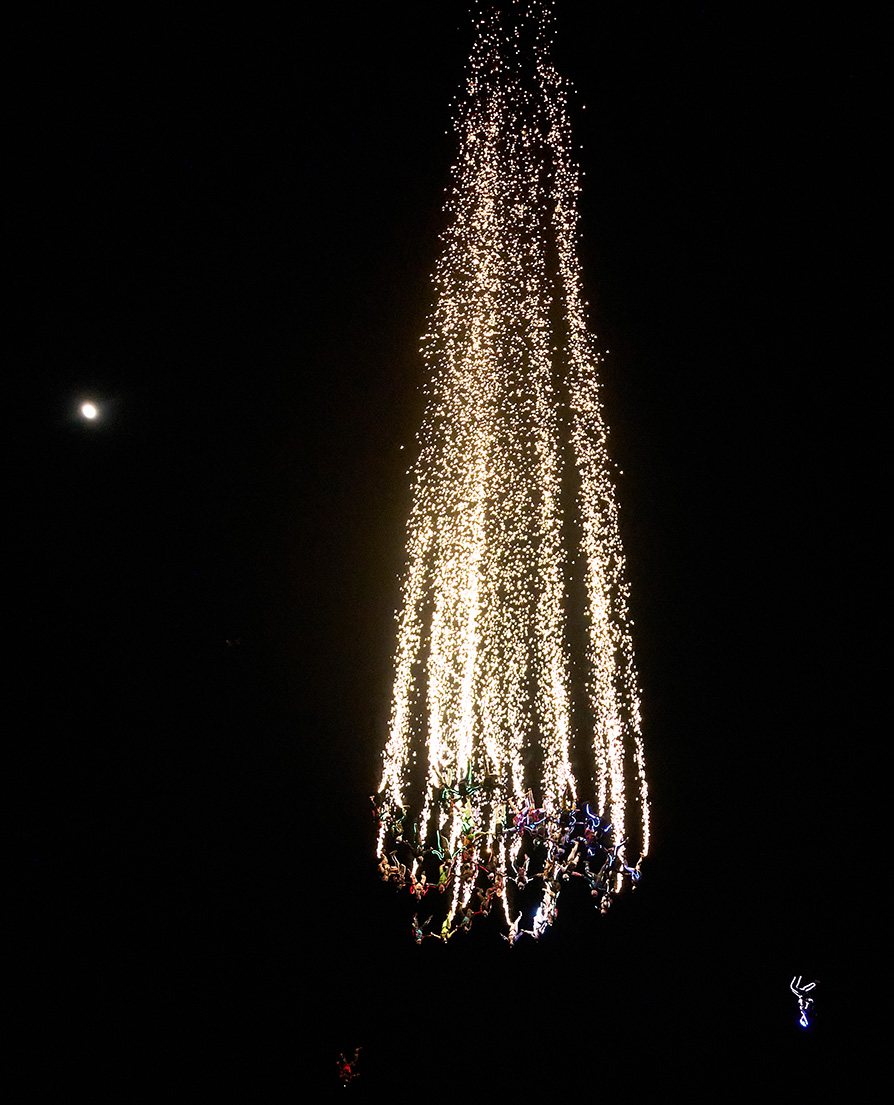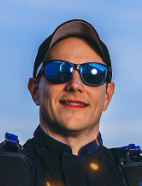All It Takes is a Spark—The Making of MAX Pyro 2.0
In the night skies above Skydive Arizona in Eloy in March, 42 LED-adorned, color-coded skydivers set the Night World Record for Largest Head-Down Formation Skydive, which is currently pending ratification by the Fédération Aéronautique Internationale. Organizers Amy Chmelecki, Sara Curtis, Steve Curtis, Matt Fry and Konstantin Petrijcuk led the effort. The pyrotechnics that the jumpers chose to use illuminated the night sky, drew crowds to the drop zone and became the talk of local communities, making the record event unique and giving it its signature name: MAX Pyro. The towering columns of burning metal, described as looking like a falling comet, spewed from the jumpers' feet as they fell through the air, creating an almost angelic appearance and drawing attention from the ground from miles away.
Night skydiving is not a common type of skydive, and for most jumpers, fairly scary. Skydives using pyrotechnics are also unusual and intimidating. High-altitude, multi-aircraft, large-formation jumps that require oxygen are slightly more common and a bit less unnerving, but they still require lots of planning and coordinating. Merging these types of skydives into one increases the complexity of planning, as well as the amount of gear each skydiver carries. Further, it exponentially increases the safety considerations and the amount of mental management each skydiver must take on.
So, how did the jumpers overcome these obstacles? And what did it take for this event come about?
History
Rewind the clock four years to early March 2020. In Texas, Konstatin Petrijcuk and Matt Fry, with Steve and Sara Curtis assisting, led a very experimental pyrotechnic event called “MAX Pyro'' to set a night world record. The event included two aircraft flying in formation at night with jumpers wearing LED strips to improve illumination (inspired by the earlier Star Search and Star Search 2.0 events) and jumping with pyrotechnics.
The group patiently waited on the ground at night in full gear for hours on end, hoping for the Texas overcast sky to clear up to give them a chance to do a night jump. After numerous day practice jumps, learning to activate pyrotechnics safely in freefall, how to safely exit aircraft with LED and pyrotechnic gear and flying with all that gear to a successful formation, the group was ready. When the pilots finally spotted a hole, the group flew to altitude. The one attempt the weather allowed was unsuccessful. Then, COVID-19 shut down the country, and the jumpers had to sit and reflect on all they had learned despite not pulling off a world record.
Today, Petrijcuk explains, “MAX Pyro is a stunt, not an event. Ever since we first attempted this, we’ve had to learn how to safely combine the different elements for night pyro skydiving. And even then, it’s just not something you can just haphazardly do, it takes considerable planning and coordination to safely conduct. After all that, there are still variables of each skydiver not performing correctly, and that must be safely accounted for. Our first event taught us a lot about how to do it safely and carefully, and where the pitfalls were to avoid catastrophe.”
Despite the weather that stopped MAX Pyro from successfully completing in 2020, it created the spark that carried over to this event and brought with it the knowledge base to address the hurdles.
Planning and Coordinating
“This event took over one year of planning” organizer Sara Curtis explained. “We had to manage procurement and costs, which kept changing over the planning period. Ordering specialized pyrotechnics to burn for a prescribed period, 30-45 seconds, with the appropriate combination of materials to not burn parachutes is no easy task, especially when supply chains are impacted. Getting planes and a facility lined up to support such a risky event, as well as get plans in place to address how to even pull it off was a lot to put together.”
The other big portion of planning was addressing the myriad things to reduce risk for the event, including how to deal with accidental discharge of pyrotechnics, the challenge of burning 84 separate pyrotechnics independently (two for each skydiver), managing the lighting and LED suits and figuring out where and how jumpers would land, how the area would be lit, where jumpers would get extra supplies … and that’s just to name a few.
While a well-thought-out plan combined with follow-through provided the answers, they all added one big, looming thing: cost. The event itself was by no means a discount event, and even with the jumpers carrying a lot of the expense, the sponsors for the event came through to make up the difference to make the event a success.
Convincing any drop zone to host and conduct such a high-risk event was also a challenge. Skydive Arizona DZO Shawn Hill was open to the event after seeing the organizers' careful and thorough planning, including the contingency plans for addressing all the high-risk parts of the event.
Organizers
Fry and Petrijcuk, the original organizers for the 2020 event, asked Steve and Sara Curtis to help again and also invited Amy Chmelecki to join the team for the latest event. With so many variables and risks involved, the event required a high level of professionalism and experience. The members of the team have thousands–if not tens of thousands–of jumps apiece.
Amy Chmeleck is a Red Bull athlete and co-owner of skydiving company Broken Records. She’s a Skydive Arizona local, a co-leader of the women’s Project-19 event and an organizer of countless other state, national, and world records attempts. She’s a founding member of the all-women Highlight Skydiving demonstration team that encourages women and girls to live bold, brave lives of their own design.
Sara Curtis is co-owner of Broken Records; the vice mayor of Eloy, Arizona; and co-owner of Arizona Arsenal, a military skydiving training service. She’s a Skydive Arizona local, a vertical formation skydiving national champion, a world medalist and co-leader of Project 19. She is also a founding member of the Highlight Skydiving demonstration team.
Steve Curtis is co-owner of Arizona Arsenal. He’s a Skydive Arizona local, a freefly and VFS national champion and world medalist and a recipient of the USPA Gold Medal for Meritorious Service. He uses his creativity to put together unique jumps, including drops of large objects such as cars.
Matt Fry is a USPA and FAI (international) Judge. He’s a pioneer at translating big-way belly techniques to vertical big-ways, and is one of the organizers for the next 200-way head-down world record attempts. He’s a freefly national champion and an international medalist. He is a Colorado local.
Konstantin Petrijcuk, a Texas local, is a larger-than-life jump organizer and the original creator of the MAX Pyro event. He’s known for pushing stunts such as skydiving with cars, flying burning parachutes and doing never-before-seen stunts off balloons to start a skydive.

Photo by Nathan Roth.
Safety
How do you stuff two planes full of pyrotechnics- and electronics-laden skydivers, carry them up to altitudes that require breathing pure oxygen, have them rush out the doors of said aircraft smoothly and pull off a stunningly picturesque night skydive successfully and, most importantly, safely? Similar to most choreographed skydiving events, it comes down to meticulous planning, numerous safety checks and lastly, practice, practice, practice of the safety drills and skydive.
The first day of the event included a multi-hour safety briefing that familiarized jumpers with the equipment and taught them how to check it and use it. The jumpers had some pertinent and pressing questions: Will the pyrotechnics burn my parachute? What happens if a pyrotechnic gets set off in a plane full of skydivers while oxygen is pumping? The safety briefing addressed these by explaining that the event’s pyrotechnics were “cold burning,” meaning that only about the first two feet of the spark showers (where the actual flames are seen) were hot. The tails of the pyrotechnics burned cooler, with the airspeed of the skydive cooling them further. With the pyrotechnics' distance from the parachutes, they were safe to operate for this purpose (a point Steve Curtis made clear by walking through a wall of pyrotechnic sparks later in the event).
Still, the skydivers were wearing flammable objects while boarding and riding a fully fueled aircraft that contained pumping oxygen, significantly elevating the risk. To mitigate these concerns, the organizers held drills and put steps into place that minimized the hazards of an accident discharge. Jumpers left their pyrotechnic activators in the off position until the door opened and ensured that the button covers of their remote activators were closed for the flight. Everyone was aware of the procedures for an accidental discharge during flight, which included using the provided fire blankets to contain the pyrotechnics and minimize injury to participants and pilots.
Equipment
Night pyro skydiving requires a lot of equipment. Jumpers for this event wore the standard required night equipment: red and green glow sticks for backup illumination, a strobe light with jumper-to-jumper visibility, an illuminated visual altimeter and an audible altimeter. But that was just the beginning. To allow color coding of jumpers in different sectors of the formation, each jumper wore an illuminated suit that consisted of strands of color-adjustable LEDS running the length of both arms and legs, as well as a controller and one or more battery packs. The jumpers also had the option of using pyrotechnic equipment, which most chose to do. This consisted of black, hot-dog-sized pyrotechnic devices connected by a cutaway-enabled ankle strap and a kiwi-sized activator box. The entire ankle assembly weighed about 3 to 5 lbs. All these pieces of equipment needed to be mounted, secured, safely operated, used and reused on each night skydive, and that required another big group responsible for the event’s success: the support team.

Photo by Nathan Roth.
Minions
Alex Fuller led the six-member support team (Bri Baker, Jonathan Comeau, Jen Davis, Waynerd Davis, Keith Senerchia and Amanda Wikramanayake), which played a huge role in the event's success, streamlining the care and maintenance of all the equipment used on each jump. The group, lovingly referred to as the “Pyrotechnicians,” “Minions” or “Fire-inions,” were responsible for removing and disposing of used pyrotechnics, mounting fresh pyrotechnics onto each ankle mount, wiring those into their appropriate activators and, for safety purposes, burning off any unfired but jumped pyrotechnics.
Fuller explained, “Each ankle unit takes about six to eight minutes to turn around from used to ready to jump. We are managing 45 units and working in a small turnaround window.” To address how to speed up the process best to prepare so many pyrotechnic units, the team found an assembly line process worked best. “Even with the assembly line, there were still challenges,” Fuller said. “We have 90 activator units, each of which has to be synced properly to one (and only one) unit to avoid unintended discharge of another unit, and confirm that for every load. We also have to troubleshoot any malfunctioned or unburned units and sort out why they didn’t burn.”
Despite the heavy workload–working feverishly to strip, zip tie, test, connect and tape down units–the team still managed to find smiles, enjoyment, and humor in their work, even wearing yellow costume hats that played into the Minion (characters from the movie “Despicable Me”) moniker.
The Team
The team of jumpers consisted of 42 participants and four camera people from 10 countries: Australia, Argentina, Brazil, Germany, France, Finland, Norway, Turkey, United Arab Emirates and United States of America. The average jump number was approximately 8,500 skydives, with a range from 1,700 to 25,000. The skydiving group itself was heavy-laden with highly pedigreed jumpers: 11 world champions and 26 national champions. Almost one-third of the group were women, a solid gain on the average 13% representation of women at most record attempts. Gustavo Cabana, James Kunze and Nathan Roth filmed the formations. Steve Curtis joined this group, gallantly coming off the formation of 43 to be an additional camera flyer to ensure that the judges had adequate footage to be able to see the grips (no easy task at night with pyrotechnics blazing).
Jump Flow
As at most big-way events, the jumpers had at least 20 to 25 minutes to prepare between jumps. This included gear checks; refreshing batteries, glowsticks and lights; and donning LED suits and pyrotechnics. After performing a final safety check, they loaded planes and took off into the darkness. The jumpers then waited around 25 minutes to reach their first major checkpoint to start the jump: the four-minute call.
At the four-minute call, all jumpers turned on their LED suits. They did so to ensure that the pilots weren’t blinded by the immense amount of light, as well as allow their eyes to adjust to the now significantly brighter light levels in the aircraft. At the two-minute call, signaled by a yellow light, the jumpers stood up, folded their benches and opened the aircraft door. The jumpers then armed their pyrotechnic devices after individually checking that it was safe to do so. They all then waited for the green light.
After receiving the cue to exit, the LED- and flammable-pyrotechnic-laden skydivers made an orderly but rapid rush out the door. After safely clearing the aircraft and other skydivers, they attempted (usually successfully) to activate their pyrotechnics. The towering column of glittering light illuminated the colorful, LED-adorned skydivers to near daylight levels and made it easy for the jumpers to find and head toward the base.
After building the formation, the skydivers broke off in two waves, providing those on the ground a spectacular view of the unified light column splitting into numerous, smaller, fiery streaks. Once deployed, the jumpers turned on their high-visibility strobes and prepared for landing. They also had the option to activate a second pyrotechnic under canopy, offering those on the ground a second show and enhancing their visibility to other canopy traffic (nothing to take lightly during a 42-person night jump).
Jumpers looked for the lights of the runway to orient themselves to the towers that illuminated the landing area and projected both where and in what direction to land. After following the agreed-upon pattern, jumpers landed in an orderly fashion, thanks in large part to the high visibility of the LED suits.

Photo by Gustavo Cabana.
The Event
The event kicked off mid-day, an unusual start time for a standard skydiving event. The organizers immediately jumped in with hours of briefing. “Anyone who says they aren’t feeling even a little bit scared during these jumps isn’t being honest with themselves,” participant Anna Moxnes (a European big-way organizer) explained. “You're scared, but you do it anyway because you've trained for it, and that's what accomplishing great things is all about." The night jumps alone were intimidating. On each of the two daytime practice jumps, the formation built and flew for more than 10 seconds, yet the night jumps proved more difficult.
The team enjoyed catered dinners, courtesy of the organizers. This generosity was also a strategic move that kept jumpers fed and focused rather than hungry and trying to find late-night meals.
During the first attempts, the practice jump went well and the unsuccessful night jumps were close but revealed minor issues of operational flow. The aircraft formation–flown by Chief Pilot Frank Frassetto in the lead plane and Skydive Arizona owner Shawn Hill in the trail plane–originally consisted of a Skyvan and Twin Otter. This changed to two Skyvans, which helped the jumpers, who were wearing all the bulky night gear, make efficient exits.
During the second day and evening, the practice jump again went well and the first night jump was a success except for a small hiccup with the position of two jumpers, leaving the declared just shy. By then, the weather forecast was starting to roll in with bad news. A large storm was coming in off the Pacific coast, and would be bringing with it heavy winds and rain. It was becoming clear there would be fewer and fewer chances to make an attempt.
After the jumpers went up on their second attempt of the second evening (the fourth night jump in total and sixth jump overall), they knew they were darn close. After exiting from 16,500 feet AGL, the jumpers built a spectacular formation of 42 jumpers, burning pyrotechnics, in a display that made the ground spectators cheer in delight. After flying the formation for more than six seconds, the jumpers broke off in formation starting at 7,000 feet and deployed their parachutes for successful and safe landings.
When onsite FAI Judge Randy Connell confirmed that the formation built, agreeing with remote judges Jim Rees and Amanda Smalley, he announced the team’s success to cheers that were almost as electric as the burning pyrotechnics themselves. After capping off the night celebrating, the team returned the following evening to increased winds but a small chance for jumping and a new challenge: dividing the team of 42 into two groups to attempt night vertical sequential records of two, three, four and five points. Two groups can jointly hold a world record if they complete their jumps on the calendar day, which made for a fun dynamic. The biggest challenge the group faced at this point was the weather … large storm clouds were rolling in and wind speeds were picking up.
The weather remained safe enough for each group to make one skydive attempt from 12,500 feet AGL, a significant reduction in time and altitude than the jumpers had hoped for. And while both teams faced very little time, one set a two-point sequential world record.
When the second group landed in higher winds than expected, and with the weather and wind forecast looking to worsen over the next day, the event officially ended. The team is already strategizing for their next ambitious endeavor, which the participants and the skydiving world are eagerly awaiting.

Photo by Nathan Roth.
 About the Author
About the Author
Ryan Sass, D-31681, calls Skydive California in Tracy his home DZ. During the MAX Pyro event, he proudly achieved his goal of being on a double-digit number of skydiving world records. He’s now earned 11 over his 174-consecutive-month skydiving career.